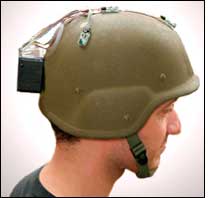Jun 01, 2009The U.S. Department of Defense doesn't take lightly to its soldiers being fired on by enemy snipers. So its Defense Advanced Research Project Agency (DARPA) asked engineers at Vanderbilt University's Institute for Software Integrated Systems (ISIS) to develop a system that could locate stealth shooters. The researchers integrated sensors and wireless technology to turn a soldier's combat helmet into a smart node that can zero in on an enemy sniper.
The smart node comprises four microphone sensors that can listen for gunshots and detect ballistic shockwaves, and algorithms that can calculate the direction from which a shot was fired, often even the location of the shooter within a few meters. When the nodes are affixed to soldiers' helmets, they form self-organizing MEMS (microelectromechanical system) networks that can communicate with each other; the more nodes, the better the accuracy of locating the shooter. "The nodes communicate via RF technology, and each has a unique ID so the person wearing the node can be identified," says Akos Ledeczi, the senior research scientist at ISIS who heads the development effort.
The nodes communicate their findings, along with their own locations and orientations, via Bluetooth to the soldiers' PDAs, which are loaded with mapping software and overhead photos of the area. The PDA displays a 3-D visual of the enemy shooter's location, along with the type and caliber of weapon being fired.
Many of the sniper detection systems currently available are limited, Ledeczi says, because they're vehicle-mounted, they require line of sight (there can't be any obstructions, such as buildings, between the shooter and the system), or they're costly to deploy. "Our system lets each soldier have a relatively cheap piece of equipment that can be built into their helmet or even their uniform," he says.
Work on the project began in 2003, and a prototype was independently tested in 2006 by the National Institute of Standards and Technology (NIST) at the U.S. Army's Aberdeen Test Center in Maryland. Six different weapons were fired 196 times from distances of 50 to 300 meters, and a 10-node network of sensors detected all the shots.
Since then, the engineers have added Texas Instruments CC1000 RF chips alongside the nodes to determine each soldier's position relative to other soldiers. That data is combined with GPS data to more precisely identify the soldiers' locations in relation to the shots fired (a technique ISIS developed and Vanderbilt University has now patented).
There's still more work to be done. At present, for example, a node runs on four AA batteries for about 12 hours, but a commercial version has to be capable of "sleeping" during normal operation and "waking up" only when necessary, to conserve battery life. The system also needs to be ruggedized and packed in weatherproof housing. Ledeczi and his team are actively looking for partners to collaborate on these revisions and develop the system for commercial use.

